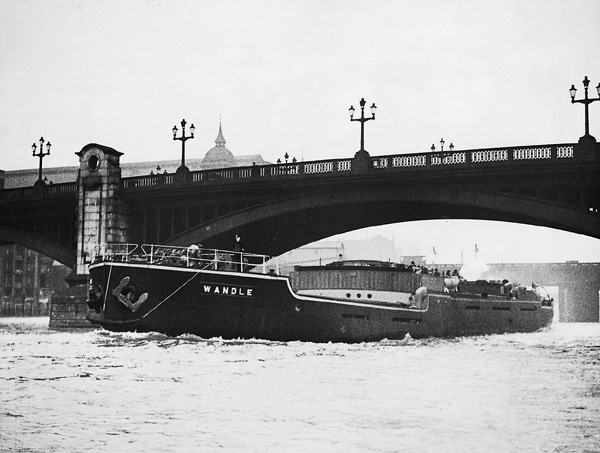Flatiron (ship Type) on:
[Wikipedia]
[Google]
[Amazon]



 A flatiron is a type of
A flatiron is a type of
''Industrial Archaeology'', edition 147
Ship types Merchant ships History of the River Thames Transport in London



coastal trading vessel
Coastal trading vessels, also known as coasters or skoots, are shallow-hulled ships used for trade between locations on the same island or continent. Their shallow hulls mean that they can get through reefs where deeper-hulled seagoing ships usua ...
designed to pass under bridges that have limited clearance. Her mast(s) are hinged or telescopic, her funnel may be hinged, and her wheelhouse may also fold flat.
Flatirons were developed in the UK in the latter part of the 19th century. Most were colliers built to bring coal from North East England
North East England is one of nine official regions of England at the first level of ITL for statistical purposes. The region has three current administrative levels below the region level in the region; combined authority, unitary authorit ...
and South Wales
South Wales ( cy, De Cymru) is a loosely defined region of Wales bordered by England to the east and mid Wales to the north. Generally considered to include the historic counties of Glamorgan and Monmouthshire, south Wales extends westwards ...
to gasworks and power stations on the River Thames that were upriver from the Pool of London
The Pool of London is a stretch of the River Thames from London Bridge to below Limehouse.
Part of the Tideway of the Thames, the Pool was navigable by tall-masted vessels bringing coastal and later overseas goods—the wharves there were the ...
.
Development
Until the middle of the 20th century flatirons were built with triple-expansion steam engines. The largest steam flatirons were more than 1,550 gross register tons. The last steam-powered flatirons were built in the 1950s. By the middle of the 1940s flatiron motor ships with marine diesel engines were being built. The largest motor flatirons were more than 1,870 GRT and more than 2,800 deadweight tons.Fleets
Some of Stephenson Clarke and Associates' fleet were flatirons. William Cory and Son's fleet included at least one flatiron. The Gas Light and Coke Company's collier fleet included flatirons to serve its gasworks atFulham
Fulham () is an area of the London Borough of Hammersmith & Fulham in West London, England, southwest of Charing Cross. It lies on the north bank of the River Thames, bordering Hammersmith, Kensington and Chelsea. The area faces Wandsworth ...
and Nine Elms
Nine Elms is an area of south-west London, England, within the London Borough of Wandsworth. It lies on the River Thames, with Battersea to the west, South Lambeth to the south and Vauxhall to the east.
The area was formerly mainly industrial bu ...
. The London Power Company's collier fleet included flatirons to serve Battersea Power Station. The Metropolitan Borough of Fulham had a flatiron fleet to serve Fulham Power Station. The Wandsworth and District Gas Company had a flatiron fleet to serve Wandsworth Gasworks.
When Britain nationalised its electricity suppliers in 1948 and gas suppliers in 1949, the new British Electricity Authority
The British Electricity Authority (BEA) was established as the central British electricity authority in 1948 under the nationalisation of Great Britain's electricity supply industry enacted by the Electricity Act 1947. The BEA was responsible for ...
(later the Central Electricity Authority), North Thames Gas Board and South Eastern Gas Board all inherited flatiron fleets from their predecessor companies. North Thames Gas had one diesel flatiron built in 1949 and the SEGB continued to have diesel flatirons built until 1956.
Decline
After the middle of the 1960s the need for flatirons started to decline. In 1966 gas suppliers started to convert fromcoal gas
Coal gas is a flammable gaseous fuel made from coal and supplied to the user via a piped distribution system. It is produced when coal is heated strongly in the absence of air. Town gas is a more general term referring to manufactured gaseous ...
to North Sea natural gas, so that by the early 1970s coal gas gasworks were being closed and demolished. Secondly the Central Electricity Generating Board reconfigured its generating capacity with small numbers of larger, more modern power stations away from the centre of London, which led to the decommissioning of Battersea A power station in 1975, Fulham Power Station in 1978 and Battersea B Power Station in 1983. By the mid-1980s the need to carry thousands of tons of coal on the Thames above the Pool of London had ceased.
Redundant flatirons were sold to private shipping companies who used them as conventional coasters. By the middle of the 1970s several had ended up with Greek or Cypriot owners. One, the SEGB's MV ''Kingston'' (1956), was renamed ''Tsimention'' in 1971 and survived until 1983 when she was broken up.
References
Further reading
*{{cite book , last=Duff , first=Peter , year=1949 , title=British Ships and Shipping, A Survey of modern Ship Design and Shipping Practice , place=London , publisher=George G. Harrap and Co.
George G. Harrap, Ltd (officially: George G. Harrap and Company Limited, London, Bombay) is a now defunct publisher of high quality speciality books, many of them educational, such as the memoirs of Winston Churchill, or highly illustrated with ...
External links
''Industrial Archaeology'', edition 147
Ship types Merchant ships History of the River Thames Transport in London